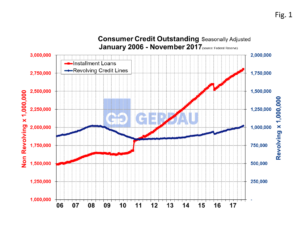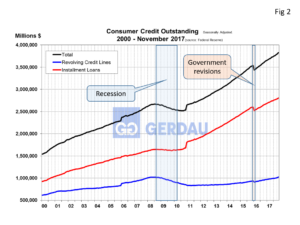Consumer Credit
Total consumer credit increased by $28.0 billion, (B) in November, well above the consensus estimate of $19.5B. The increase was far higher than the $20.5B increase in October and the largest increase since November 2001. This makes three months in row that total credit has surpassed analyst’s projections. Non-revolving credit advanced by $16.8B while revolving credit moved-up by $11.2B.
On a percentage year on year basis, consumer credit increased at a annual rate of 8.8%. Revolving credit increased at an annual rate of 14.1% percent, while nonrevolving credit increased at an annual rate of 7.5% percent.
Consumer credit represents loans for households, for financing consumer purchases of goods and services, and for refinancing existing consumer debt. Secured and unsecured loans are included, except those secured with real estate (such as mortgages and home equity loans and lines). The two categories of consumer credit are revolving and nonrevolving debt. Revolving debt covers credit card use for purchases or cash advances, store charge accounts. Nonrevolving includes auto loans, personal and student loans and other miscellaneous items such as recreation vehicle loans.
 Figure 1 shows consumer credit outstanding from 2006 to present. The blue line represents revolving credit, while installment loans, is illustrated by the red line. Consumers have been more careful with revolving credit since the great recession, the current level is just now reaching the peak achieved in 2008. Figure 2
Figure 1 shows consumer credit outstanding from 2006 to present. The blue line represents revolving credit, while installment loans, is illustrated by the red line. Consumers have been more careful with revolving credit since the great recession, the current level is just now reaching the peak achieved in 2008. Figure 2 takes a longer term view of the same data. The “great” recession on this scale shows-up as a speed bump on the road.
takes a longer term view of the same data. The “great” recession on this scale shows-up as a speed bump on the road.
Consumers are confident in the economy and thus are willing to take on debt to finance their purchases. Headline credit logged its largest gain in 16 years. Nonrevolving credit reached a multiyear high, while revolving credit logged its largest increase in 2017. Debt burdens and financial obligations remain near their lowest levels in history, while delinquency and default rates are at multi-decade lows. The savings rate is comfortably high which should allow consumers to increase their spending and borrowing without too much financial strain.
Risks on the horizon include the uncertainty surrounding the healthcare marketplace and geopolitical tensions. Higher interest rates could also present challenges since debt servicing will rise on revolving credit, while higher borrowing costs will inhibit growth in both the home mortgage and auto markets.
At Gerdau, we monitor consumer spending because history has shown that increased consumer spending (approximately 69% of GDP), translates into increased steel consumption (and vice versa).

